Hours of customization and character building in only 8 bits of graphics. RPGs finally made their move away from pen and paper and onto the screen in the 8-bit era, and nowhere was this more plentiful than the Nintendo Entertainment System.
Though it’s been over 30 years since it debuted, the NES still boasts some classic and innovative RPGs. If you’re looking for a trip down memory lane, or a dive into a time you never played through, here are 20 Of The Best NES RPGs You Need to Play.
The 20 Best NES RPGs
20. The Bard’s Tale
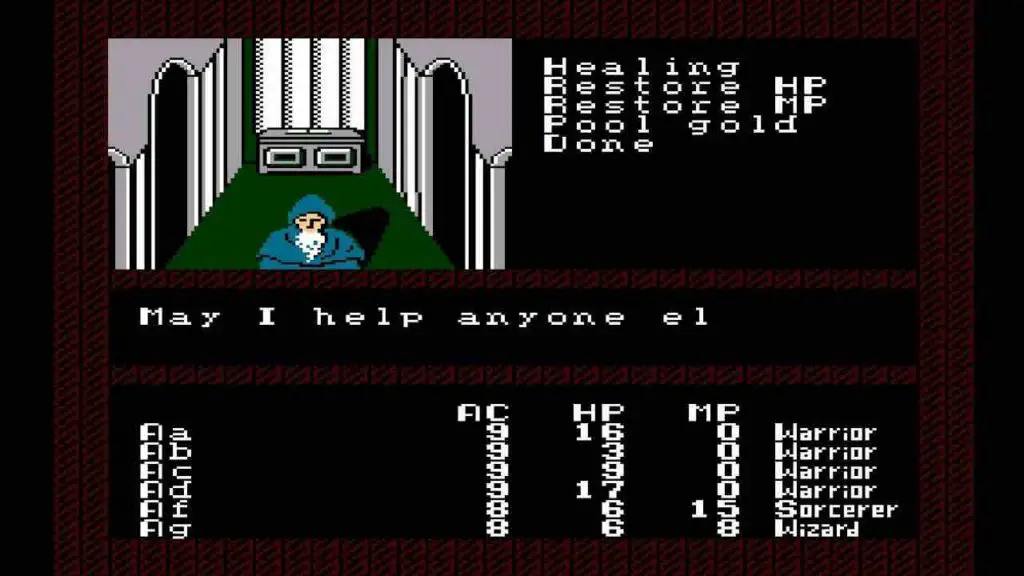
Our first of the best NES RPGs, The Bard’s Tale was released on many different systems (Commodore 64, Macintosh), before finding a home on the NES. The home computer versions were widely praised at the time, with a heavy focus on how beautiful the graphics were.
The NES, unfortunately, had some hardware limitations, and Nintendo’s version of The Bard’s Tale was significantly less elegant than those on home computers. Additionally, the game itself was shorter, and Nintendo removed all references to wine, ale, and heaven (something difficult in a game that has a dungeon in a wine cellar).
Adaptations aside, The Bard’s Tale follows a group of adventurers that form a party in the town of Skara Brae. Within Skara Brae are five dungeons that the party traverses, ultimately defeating the evil wizard Mangar. Relatively typical RPG fare, but it was helped along by having the entire game set within a single town, as well as the introduction of the Bard, whose singing ability provided RPGs with perhaps their first instance of character buffs in a game.
19 Willow
Released as a tie-in with the Ron Howard film of the same name, Willow was a high fantasy, Zelda-inspired action RPG that deviated significantly from the film. The character sported a sword and shield, as opposed to the walking stick in the film, and he traversed this game alone. Players solved quests, fought enemies, gained levels — typical RPG elements. The major difference between standard RPGs and Willow was that Willow used a password system as opposed to the newly minted battery-operated save feature.
While economic, this was criticized at the time. The game has never been rereleased for any new Nintendo system, making it a bit of a lost legend.
18. Swords and Serpents
Swords and Serpents was a standard RPG that dealt in typical high fantasy tropes. You and up to three additional friends control a party of adventurers who go through an underground dungeon to defeat an evil serpent.
Character stats were randomly determined, and, like many lower-class RPGs, Swords and Serpents used a password system to load progress. While trawling through the dungeon, the view is split between a top-down map, and a first person representation of the dungeon. The dungeon crawling nature, along with the difficult battles were praised at the time, with critics noting the adrenaline-inducing nature of knowing any turn could lead to death.
17. Legacy of the Wizard
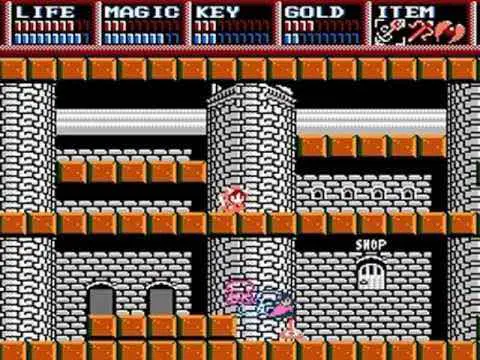
Legacy of the Wizard is another RPG that deals in classic high fantasy tropes — common of RPGs from the 1980s, as they had yet to break out of that mold. The game deals with a family who must destroy an ancient dragon in an underground labyrinth (sound familiar). Where Legacy of the Wizard deviated from other games, however, was in its creation of the adventuring party. LoW had a family, and each member possessed unique skills and attributes that came in handy in different parts of the game — a relatively unusual feature at the time.
Additionally, Wizard had an unbelievably massive map with five unique labyrinth areas. The map required a significant amount of backtracking, which, while frustrating, significantly increased the playtime and difficulty of the game.
Certainly not the most impactful RPG, Legacy of the Wizard nevertheless had solid bones and a few interesting twists that allowed it to rise above the basic tropes it was built upon.
16. The Magic of Scheherazade
Another of the “inspired by The Legend of Zelda” breed, The Magic of Scheherazade follows an amnesiatic hero who must rescue the Princess Scheherazade from the clutches of the evil wizard Sabaron. The game combined some elements of more action-oriented adventures (such as Zelda) with additional turn-based combat (in the vein of Final Fantasy), as the player traveled across five different worlds. Unique at the time, Scheherazade also had a time travel element, thus allowing the player to access different eras of the same worlds. Two forms of combat across space and time!
Beyond that, Scheherazade introduced the two player combined attack into RPGs, something that classics such as the Tales series uses to this day.
Though the game was slightly hampered by using a password-based system of saving, players figured out that the passwords allowed for multiple errors to be inputted and still be accepted. This ultimately led to two-digit passcodes being discovered that would load a character at chapter starts with max equipment — a bit of an oversight, but a welcome one at that.
15. Faxanadu
Faxanadu is unique in that it was a side-scrolling RPG that combined elements of action-adventure and platforming into an RPG experience. You play as a nameless hero who returns to his hometown to find the town in shambles and under attack from the once peaceful dwarves. To save the town, you must revive all of the dried-up springs, restore life to the world tree, and defeat the evil one who has been corrupting the dwarves.
It has classic RPG elements, such as buying new gear, as well as combat and platforming much more similar to Zelda II. (Where could that appear on this list?) Unfortunately, it too is hampered by a password system that doesn’t allow you to properly or frequently save progress. Despite this limitation, it was well-received upon release, and was made available again for the virtual console back in 2011.
14. Earthbound Beginnings (Mother)
Known as Earthbound Beginnings outside of Japan, and Mother in its native country, this RPG is a significant departure in style and substance from the previous RPGs on our list. It takes place in the late 20th century U.S.A, making it our first RPG not steeped in High Fantasy trappings and lore.
Released exclusively in Japan until 2003 when it made its debut on the GBA, Mother followed a young boy named Ninten who gained psychic powers following a paranormal incident. He then has to travel with his new friends, Lloyd and Ana, to discover eight most melodies, doing battle with strange and mysterious creatures along the way, before eventually defeating a malevolent alien presence.
While critics praised the departure from traditional RPG trappings, along with the addition of fun household items as weapons, they were sharply critical of the uneven scaling, heavy grinding, and high difficulty level. The sequel, Earthbound for SNES, rectified a lot of these issues, being considered almost a soft-remake of the original Mother.
Still, Mother stood out as a bold departure in a sea of high fantasy copycats, making it one of the best NES RPGs ever made.
13. Destiny of an Emperor
Another of the best NES RPGs, Destiny of an Emperor is another departure from our typical high fantasy setting. It takes place in the Three Kingdoms period of China and focuses on a small militia that forms to defend its village from rebels. As the game progresses, the player can form a party of up to 70 characters, in a branching storyline that concludes with the successful unification of all of China.
Destiny of an Emperor was quite innovative in its battle mechanics, as defeated units could often be recruited into the party, and ejected party members could morph into enemies. On top of that, there was a battle option called “all-out,” which allowed the computer to speed-up and auto-play an entire battle without human input, relying on stats alone.
12. Ultima III

Another port from the computer to the NES, Ultima III came out seven years after it’s computer debut, and had to have its graphics completely overhauled. The result was a significantly more JRPG look, that still retained the overall plot and mechanics of the original game.
In Ultima III, the player and a gang of adventurers sets out to defeat Exodus, an evil AI that threatens the world of Sosaria. The player must collect four magic punch cards and insert them into Exodus to defeat him.
Though Ultima has classic RPG combat, it also included puzzle-solving mechanics, as well as gaining clues from townsfolk. The difficulty of dungeon enemies was not generated against the player’s level, but by the dungeon level, a feature which could cause the player to suddenly find themselves heavily outmatched.
The coherent plot as well as the surprising depth and complexity of play were praised upon release, thus earning Ultima III spot number 12 on our Best NES RPGs list.
11. Pool of Radiance
Noted for being the first video game adaptation of Advanced Dungeons and Dragons, Pool of Radiance tread the typical High Fantasy ground that RPGs popularized.
Pool of Radiance is set in the city of Phlan, which has fallen into ruin. The player and a band of adventurers must rescue the city by driving out the monster threat, which culminates in a battle against the evil Tyranthraxus — an evil spirit who has possessed a dragon.
One feature that made Pool of Radiance stand out was that it featured a save system, something that allowed more customization of character race and class to be continued over when the player turned off the game. Though this seems standard now, the memory required for this feature was substantial, and many games resorted to password features which severely limited character choices and customization.
The NES adaptation arrived quite late in the NES lifecycle — 1992, 2 years after the SNES debuted.
10. Fire Emblem Gaiden

The story centers around two armies, led by Alm and Celica, which eventually work together to destroy the war god, Duma, in a quest to bring peace to two warring nations — tropes that strayed from typical 80s RPGs and toward what would become standard of the budding JRPG genre.
The immediate successor to the next game on our list (spoilers!), Fire Emblem Gaiden was designed to rectify several of the perceived flaws of its predecessor, namely the tedious map navigation. Additionally, a new memory chip was added to help improve the graphics (which were notably muted in the original Fire Emblem in order to focus on the sprawling battle system). Still, the fixes to graphics and navigation were prioritized over the difficulty, and the general consensus was that Gaiden offered an easier adventure than its predecessor.
This refocusing of energy away from difficulty knocks Gaiden down to ninth on our list of Best NES RPGs, right behind …
9. Fire Emblem: Shadow Dragon and the Blade of Light
Easily one of the Best NES RPGs, Fire Emblem practically brought tactical role-playing into existence single bladedly.
Fire Emblem revolved around Prince Marth in his quest to regain his throne and defeat the evil wizard Gharnef.
Where Fire Emblem deviated was in the execution of the battle sequences. Fire Emblem was a tactical RPG, where players control a group of units that they move across a battlefield grid to then engage with enemy combatants. Importantly, Fire Emblem featured permanent death, where if a character from the player’s campaign died, they would be removed permanently from the party and story.
This innovative design and increased difficulty catapulted Fire Emblem into a class of its own which ultimately spawned an incredibly successful franchise.
8. Dragon Quest/Dragon Warrior
Dragon Warrior in the United States, Dragon Quest in Japan.
This classic NES RPG was inspired by previous RPG entries, such as Ultima, but with a stronger emphasis on story and a simplified interface, both choices done to allow players unfamiliar with RPGs to pick up Dragon Warrior/Dragon Quest with relative ease.
In Dragon Quest, the hero stumbles upon Tantegal Castle, where the princess has been kidnapped by a dragon, and he immediately sets out to rescue her. Basic stuff? Not so fast! Once the Princess is rescued, it turns out that is only the first element in a larger quest to save the larger kingdom. In this next journey, the hero must collect hidden relics, battle through a castle, and then defeat the Dragonlord, before finally restoring light to the land.
Combat is typical of the RPG genre, though significantly pared down from more convoluted entries on our list. Progress is saved in the North American version, though in the original Japanese version relied on a password system (a major hindrance). Still, the focus on character, as well as clearly defined and easy to follow objectives were lauded, and it became a great entry point for new players into the daunting NES RPG genre.
7. Ultima IV
Ultima IV took a significant departure from the rest of the Ultima series in that the main goal of the game was not to defeat legendary evil, but to level up eight virtues within the character himself to become a spiritually enlightened being called the Avatar who would become the religious leader of Sosaria.
This bold departure required actions to have consequences within the game, as even casual actions such as conversing with NPCs would level up or down certain virtues.
This dynamic system, combined with typical RPG adventuring markedly increased game length, as it was quite a task to build up all eight virtues to the max level before descending into the final dungeon.
For its addition of an ethics system, and an overworld map sixteen times the size of Ultima III, Ultima IV’s unique adventure lands at 7 on our greatest RPGs for the NES.
6. Sid Meier’s Pirates!
Pirates was an open world, open sea adventure where the player controlled a pirate, privateer, or pirate hunter in the Golden Age of Piracy.
You start out receiving a letter of marque from one of the colonial powers at the time, and from there are given relatively free reign to attack towns or hostile ships. Additionally, the player can start the game at several predetermined times in the era, which affects the types of ships, volume of ship traffic, and hegemony of different countries in the game.
The game has no specific end, but gameplay becomes harder as it goes on, with fewer recruits signing up for your crew, and a dwindling health bar as your character ages. Eventually, you must retire, at which point the game ends and you are granted a rank in accordance with your performance.
5.Digital Devil Story: Megami Tensei
DDS was only released in Japan, but the Megami Tensei series eventually found success worldwide in the later decades. In DDS, the first of the series, a young boy in high school develops a computer program that allows him to summon demons.
The program, however, quickly turns malevolent, and unleashes a horde of demons. The main character must partner with a transfer student to enter an underground labyrinth and ultimately defeat Lucifer.
Combat is standard RPG fare, with a first-person perspective in the labyrinth. However, DDS truly stands out with its genre-defying plot — being set in a modern Tokyo high school that then becomes infested with high fantasy and quasi-religious elements. This mature and bold plot was a profound departure from ground tread by most RPGs, paving the way for more games to break the mold.
4. Dragon Quest III
This SNES RPG greatly expands upon its immediate two predecessors, both in plot and mechanics.
For gameplay specifically, Dragon Quest III allowed the player to choose a character of either gender, a real rarity at the time. The rest of the party could be a member of many different classes and could be male or female. Additionally, characters’ classes could be swapped later in the game while retaining certain skills, a feature that allowed for a heavy amount of customization.
Plotwise, the game was set prior to DQI and follows a 16-year-old hero who must rid the world of an evil fiend Baramos. The twist, however, comes later in the game, when the hero follows Zoma, the overlord, into the dark world, which turns out to be none other than the main realm of the original game!
This key element of universe building, combined with an expanded job system worked to greatly expand the in-game possibilities, making this number four on our list of Best RPGs for the NES.
3.The Legend of Zelda II: The Adventure of Link
Now we’re getting into the heavy hitters. Zelda II, was easily one of the best NES RPGs. It was an innovative departure from the original Zelda, that overhauled combat and exploration while maintaining the fantasy trappings that made the original so successful.
Zelda II picks up where the original leaves off, with Link having to awaken the sleeping princess, by placing six crystals inside of six statues to reveal the triforce of courage.
Zelda II added Zelda standards, such as the magic meter; and introduced the world to Dark Link and the Iron Knuckle. However, it’s side-scrolling nature and increased difficulty were criticized, with the side-scrolling nature never being replicated in any further Zelda adventure.
2. Final Fantasy
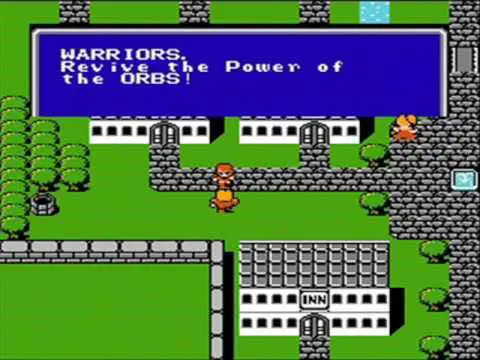
The game that spawned one of the greatest video game franchises of all time: Final Fantasy.
Almost the best NES RPG, FF was developed by Square, after seeing the success of Dragon Quest. Throughout the process, Square was skeptical of whether the game would be successful. This, coupled with Square’s financial difficulties, contributed to the title “Final Fantasy,” as it could have been both the first and last game of the series.
Luckily, FF was a smashing success. The game centered around four light warriors, who had to travel the world to purify the four darkened elemental crystals and restore balance to the world.
This crystal element, along with the class system of the heroes, would become both series and industry staples in the coming years. Though Final Fantasy seemed similar to many other RPGs, it deviated by introducing faster travel options that were progressively unlocked, as well as a marked graphics upgrade, and a clean, elegant combat screen.
Players traversed over dozens of locations sprawled across three continents, progressively leveling up their characters, unlocking abilities, and revealing a unique story that took advantage of RPG tropes without being weighed down by them.
The departure from traditional dungeon crawling, unique class system, clean visuals for battles, and immersive story serve to create a remarkable piece of video game craft — standing head and shoulders above nearly every other NES RPG released.
Except one.
1. The Legend of Zelda
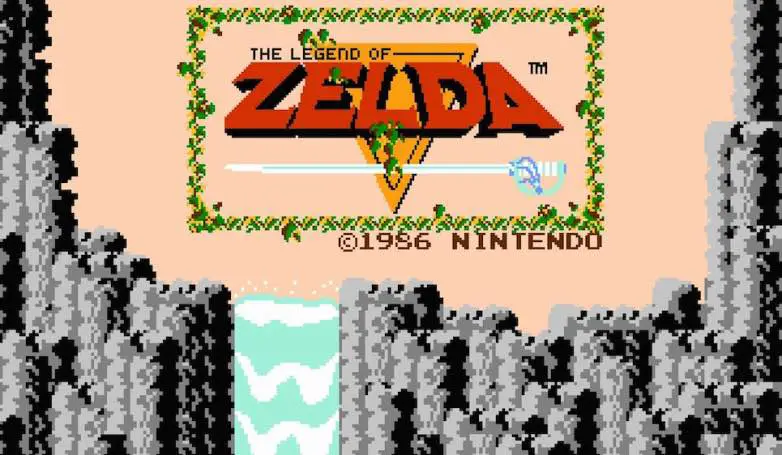
Easily one of the greatest games ever released, let alone the best SNES RPG ever, The Legend of Zelda immediately thrusts Link, a young warrior, into the world of Hyrule, where he must quest to retrieve the 8 pieces of the triforce of wisdom from difficult dungeons, defeat Ganon, and save Princess Zelda.
From the start, the game introduces an element of exploration and adventure. Link quickly wanders into a cave where an old man cries, “It’s dangerous to go alone, take this,” and gives Link a sword.
Combat was not turn-based, but real-time. Link had to fight his way through dungeons filled with fast-moving, hard-hitting enemies. He gained advantages not by leveling up, but by gaining unique weapons, and increasing his health after boss fights.
Along with fast-moving enemies, the dungeons featured puzzle elements, which required the player to be adept at battle and problem-solving. The real-time nature of the battles kept the pace quick, and a real sense of adrenaline built up in the player, as reflexes often determined the difference between victory and defeat.
The impact of this game is difficult to overstate. It was the first NES game to sell over 1 million copies, and it spawned one of the most successful video game franchises of all time. Several games considered the greatest of all time, such as Breath of the Wild and Ocarina of Time, would never have happened, had it not been for the success of Link defeating Ganon for the first time in 1986’s The Legend of Zelda.
We hope you enjoyed our list of the Best NES RPGs. Don’t agree with us? Let us know what we missed in the comments!
Want More Great Posts Like This?

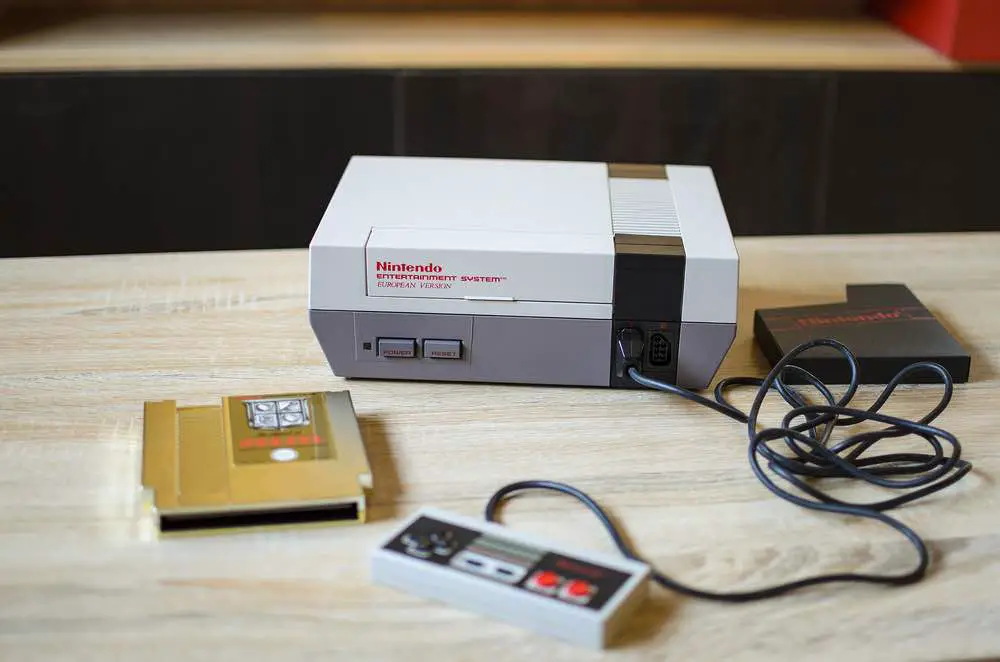
HTF is Chrystalis not on this list??????????????????